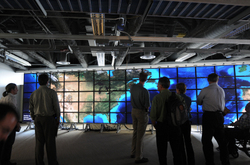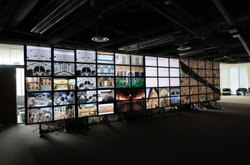What is Hip? HIPerSpace World's Highest Rez Display
Don't think the kids at the University of California, San Diego are slacking off, surfing all day and beach-partying all night. The California Institute for Telecommunications and Information Technology, is showing off the world's highest-resolution display system at UC San Diego. How big is big? 287 million pixels, which means it has 10% more pixels than the second-largest display in the world that's currently with NASA.
The HIPerSpace isn't a single solid display, but an array of 14 columns with 5 rows of displays. Yup. Do the math: That's 70 high-resolution displays. The displays are made by Dell, and each features a resolution of 2,560 by 1,600 pixels. Ready for more math? That's 35,640 by 8,000, or 286.7 million pixels. That's a lot of pixels. Well, at least I think so.
The processors needed to power this monstrosity are equally impressive. As you would expect, it uses Dell computers - 18 Dell XPS 710/720s with Intel quad-core CPUs and dual Nvidia FX5600 GPUs.
 This system isn't designed for entertainment - serious processing power for serious applications. HIPerSpace -Highly Interactive Parallelized Display Space project - was shown to the National Geographic Society, and according to a press release from the university, it's intended for uses such as climate change predictions, human brain exploration, seismic activity impact, and even in the arts. The Palazzo Vecchio was laser-scanned for detailed study.
This system isn't designed for entertainment - serious processing power for serious applications. HIPerSpace -Highly Interactive Parallelized Display Space project - was shown to the National Geographic Society, and according to a press release from the university, it's intended for uses such as climate change predictions, human brain exploration, seismic activity impact, and even in the arts. The Palazzo Vecchio was laser-scanned for detailed study.
"By using larger, high-resolution tiles, we also have minimized the amount of space taken up by the frames, or bezels, of each display," says Kuester, the Calit2 Professor of Visualization and Virtual Reality, and associate professor in the Jacobs School of Engineering's departments of Structural Engineering as well as Computer Science and Engineering. "Bezels will eventually disappear, but until then, we can reduce their distraction by keeping the highest possible ratio of screen area to each tile's bezel." Including the pixels hidden behind the bevels of each display, which give the "French door" appearance, the effective total image size is 348 million pixels.
 While this won't be making an appearance in home theaters any time soon, one can only imagine what something like Discovery's Planet Earth would look like on this system. -Leslie Shapiro
While this won't be making an appearance in home theaters any time soon, one can only imagine what something like Discovery's Planet Earth would look like on this system. -Leslie Shapiro
- Log in or register to post comments





















































